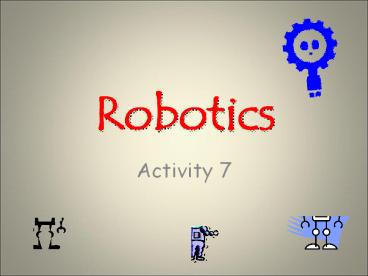Robotics - PowerPoint PPT Presentation
Title:
Robotics
Description:
Robotics Activity 7 Robots around the world Let s have a look at a some more examples of robots in action around the world. Animal Robots http://www.youtube.com ... – PowerPoint PPT presentation
Number of Views:49
Avg rating:3.0/5.0
Title: Robotics
1
Robotics
- Activity 7
2
Robots around the world
- Lets have a look at a some more examples of
robots in action around the world. - Animal Robots
- http//www.youtube.com/watch?viMLwm1ofO_Efeature
related - http//www.youtube.com/watch?vj2el0XRwr8Efeature
related - Robots are not always people-like they are
useful machines too.... - http//www.youtube.com/watch?vNy5IfQsK9s0feature
fvwrel
3
Aims of Activity 7
- To run the robot so that it detects and reacts to
black tape lines
4
Materials for Activity 7
- Working robots (without switch controller)
- Black tape and Berol Broad felt-tip pens (1 pen
per team) - Square sheets of white paper
- Activity 7 video
- Activity worksheet
5
Background for Activity 7
- A robot needs sensors to find things out about
its environment. - Discussion What sensors (senses) do people have?
- Eyes (sight), ears (sound), nose (smell), fingers
(touch), skin (temperature), tongue (taste) - Discussion What sensors (senses) does Robokid
have? - Eyes (sight), switches (touch), battery checker
(hunger). - This activity will concentrate on using two of
the robot eyes.
6
Background Experiment 1
- The two optical sensors at the front of the robot
can detect the difference between black tape and
white paper. - These two eyes are located at the front of the
robot and look down at the floor. They work by
sending out some infra-red light and looking at
what bounces back. A lot bounces back from white
paper, but very little returns from the black
tape. The robot computer converts the result to
a number and uses it to plan its operation.
7
The Robots eyes....
8
- Our eyes cannot detect infra-red light so we will
not see the beam. In fact, this light is used by
TV remote controls to pass signals to your TV. - The light is called infra-red because it is
just above the red light of the visible light
spectrum. - Some animals can see infra-red light. For
example, some snakes have little infra-red eyes
(called pits) as well as normal eyes.
9
- Experiment 1 shows the robots basic avoidance
strategy. As soon as it detects the line it
stops, reverses for a small period of time, then
spins for a small period of time before heading
off in a new direction. As it always uses the
same avoidance mechanism, shapes drawn on the
sheet will have regularity to them. However, the
final pattern will be heavily dependent on the
shape of the black tape perimeter. We will try
to get each team to use a different shape.
10
Activity 7 Video
- This video shows all of the experiments together.
- After the video, I will go over each experiment
in turn to remind of the steps you must carry
out. I will also give you a worksheet that breaks
down each experiment and explains the sequence of
tasks. - http//www.youtube.com/watch?viJPfQqrsib0feature
player_embeddedat24
11
Experiments
- For the next few slides, I would like you to
refer to your worksheet and follow it as I go
through each experiment. - Please make any notes on the sheet that you think
might help you or remind you of important things
you must do to ensure the experiment works.
12
Experiment
- Get a sheet of white paper
- Create a closed shape with the black tape
- Set robot into mode b0 (power-on then A_2D_2A)
- Place in centre of area and check that it works.
- If all is OK insert a Berol Broad felt tip pen in
pen holder - Make sure that the tip of the pen is touching the
paper - Press switch A to start
13
Possible Problems
- The Robot will stop for the following reasons
- If it has been running for 2 minutes (this is
called a time-out) - If switch A has been pressed and held for a
couple of seconds. Pressing switch A will
restart - If switch C has been pressed and held for a
couple of seconds. Exits the mode shown by
flashing b0 message
14
Experiment
- Switch B can be pressed to change how the robot
reacts. The things that can be changed are set
by POT-1, POT-2 and POT-3. - POT-1 Sets the amount of reverse when robot
detects the black tape - POT-2 Sets the amount of spin after the robot
has reversed - POT-3 Sets the speed difference between the two
motors. A greater difference means that it moves
in a tighter curve. - Try changing the parameters and looking at the
results - Create a multi-colour picture by swapping pens
with other groups.
15
Experiment
- Reverse paper and create new shape
- Run the bug bump mode Mode b1 (switch
sequence A_2D_A_D_A) - Press switch A to start
- Robot will stop as in experiment 1
- This mode introduces randomness into the robots
decision making by making each decision reliant
on a random values. The effect is if the robot
has an internal dice which is used to get random
reverse and spin times. - Compare two drawings, one from the predictable
mode and one from the bug mode.
16
Experiment (if time)
- How does the sensor work? We can try some simple
tests with other things that are black - Black felt-tip pen
- Black paint (ensure it is dry before starting
the robot) - Black ink
- Black photocopier ink































